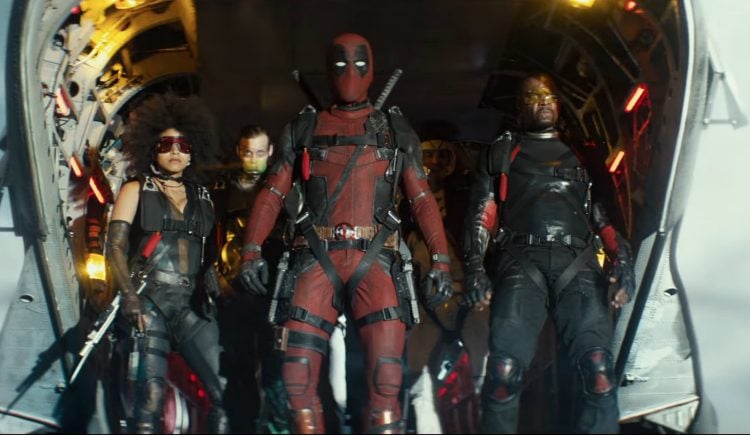They say “you can’t go home again.” I’m not sure who “they” are, exactly, or why they are so averse to letting you return to your place of residence, but the phrase colloquially means that you can’t return to a place that you remember from your past, as it won’t be the same now as how you remember it being in your mind.
Such is the case with “Once Upon a Deadpool.” A brand-new movie that was released less than 7 months ago has been repackaged and re-issued in theaters, with the inclusion of some alternate takes of existing scenes, a few snippets of new(ish) scenes, and a PG-13 rating to replace the original, ever-scary R rating. Oh, and Fred Savage.
The plot of the film itself remains unchanged: mercenary for hire Wade Wilson, aka Deadpool (Ryan Reynolds), is trying to juggle being a contract killer with having a semblance of a “normal” home life with his girlfriend Vanessa (Morena Baccarin); when the two worlds collide, however, Vanessa is tragically killed and Wade realizes he’s lost the most important thing in his life. Matters are complicated when he reluctantly agrees to help protect youngster Russell (Julian Dennison) from the sudden time-traveling appearance of Cable (Josh Brolin), who wants to kill the kid in the present to avoid the rampant murdering he’ll do in the future. Throw in a few X-Men (not the really popular ones, of course) and a newly-formed X-Force (featuring Zazie Beetz’s Domino, among others), and the audience is in for one foul-mouthed, meta-heavy ride.
That was “Deadpool 2,” a commercial success when it came out in May 2018. “Once Upon a Deadpool” differs in only a few key ways, really. The “foul-mouthed” aspect is heavily reduced, as is the violence and gore (I always find it amusing that PG-13 films are allowed a certain amount of vulgar language and seemingly unlimited sexual innuendo, but GOD FORBID you show a gunshot wound that has lots of blood or someone getting a limb cut off!). To combat/explain this, the “meta-heavy” aspect of the film goes next-level, with a brand-new intro and cut scenes that feature Deadpool as he has kidnapped a now-adult Fred Savage and has forcibly returned him to the recreated bedroom set of the classic film “The Princess Bride” – much as the young Savage did as an actor in that film, here he listens to Deadpool re-tell the story of “Deadpool 2” to him by reading it out of a book (hilariously titled “Deadpool 2: King James Edition” on the spine of the tome). P.S. Savage is tied to the bed and forced to listen, in typical insane-Deadpool fashion.
First things first: the Savage-Deadpool cut scenes are really entertaining. It’s clear that this recreation/homage to the classic ’80s film that we all know and love was a great idea, and Savage fits rather seamlessly into the self-referential universe of the Deadpool films. Of particular mention are two scenes: one where he talks about wanting to fight another Hollywood celebrity (one that briefly appears uncredited in “Deadpool 2,” no less) but Deadpool uses his handheld censor-beeper to beep the word “fight” so that everything sounds much dirtier, and another where Savage chides Deadpool for including the character of Cable in the film but not utilizing or even referencing any of the character’s rich comic-book history. Good stuff!
Unfortunately, the new Savage-Deadpool dynamic comes at the expense of pretty much ruining “Deadpool 2” as a movie. Where the original succeeded by fully embracing and reveling in its “adult” meta-status, this aspect was attempted to be surgically removed for “younger audiences” to enjoy here – and the surgery is, sadly, a hack job. The movie’s narrative becomes jittery and disjointed, and scenes that you remember so fondly from your viewing of “Deadpool 2” essentially become neutered and lifeless in “Once Upon a Deadpool.” So, the question is begged, then: is it worth it to essentially butcher a feature film just for the chance to add a few new disconnected scenes? The answer has to be “no,” and this is where “Once Upon a Deadpool” becomes a failure as a “new” film.

When the Will Ferrell-led comedy “Anchorman” was released in theaters back in 2004, there were enough cut scenes and alternate takes for the creative team to produce a loosely-connected secondary film – which they did. Titled “Wake Up, Ron Burgundy,” the movie was very strange – but was released only as a special-edition “bonus feature” on certain “Anchorman” DVD sets. If DreamWorks had elected to try and release “Wake Up, Ron Burgundy” theatrically, it would have had a similar feel that “Once Upon a Deadpool” elicits: a mistake to try and market as a “wide release” in asking audiences to pony up even more money to see a film that really isn’t new and didn’t necessarily need to be made.
“Once Upon a Deadpool” is an intriguing idea, to be sure, and could have worked very well as an “extra” on a “Deadpool 2” home-video release; presented as a standalone film released in theaters to paying audiences, however, it feels like a sad attempt at a money grab, and may end up tarnishing the overall “legacy” of the Deadpool cinematic franchise.
![]()


